The world has been plunged into darkness. The dead persist violently among the living. What remains of humanity following a cataclysm I helped trigger is now at each other’s throats. I carry my share of the blame, but it’s clear the gods must pay for what they’ve done to us. There’s a path to seeking justice, and it must be cut through legions of monsters, human and undead alike. I’m up to the task, equipped with strength, resolve, and help from an unlikely source. With each foe I strike down, I learn more about myself. I learn that I’m not powerless. States of failure and struggle aren’t permanent. Nothing will stand in my way.
Even gods can die. And I’m going to kill them.
Flintlock: The Siege of Dawn is the latest game from developer A44 Games, the team behind 2019’s Ashen. A soulslike set in what the developers refer to as a “Flintlock fantasy,” where magical fantasy is fused with black powder-powered firearms, the roughly 10- to 20-hour story follows the struggle of Nor Vanek, a trench digger who finds herself in the middle of a world-changing event that unleashes the power and wrath of ancient gods upon the world, sending it into a state of misery and despair as undead roam the land and human factions find themselves corrupted by twisted ideologies and faith. With an ax in one hand and a black powder pistol in the other, Nor sets out to take on the gods and right what went wrong. But she’s not alone.
Buy Flintlock: The Siege of Dawn: Amazon | Best Buy

Accompanying her is Enki, a god taking the form of a small, adorable, feathered fox. After convincing Nor of his seemingly good, though mysterious, intentions following the cataclysmic event that sends the world spiraling into chaos, Enki grants Nor the gift of magic as well as companionship as the two set out to make things right in the world.
Those magical abilities provide Nor with the ability to deal extra forms of damage and unleash status effects on her enemies, as well as traverse the world through triangular rift gates to access new areas and speed along on trips through previous routes. The core structure is standard soulslike: You explore the world to take on challenging foes, earning a form of experience as you do to level up your character. Die and you drop all the experience you have on you until you return to reclaim it. Die before reclaiming the experience and it’s lost forever. Study your enemies’ moves carefully, strike when the time is right, block, parry, and dodge to ward off their attacks, and you just might make it through alive.
Where Flintlock departs from many of its genre siblings is that here, you almost certainly will survive because, though it has much in common with the likes of Dark Souls and Elden Ring, it’s remarkably more forgiving across its three adjustable difficulty modes, one of which allows you to turn on infinite health. Though a lower level of difficulty might not exactly be an irresistible siren’s call for those Souls fans who love the genre for its robust challenge, by lowering the difficulty threshold, Flintlock may allow more players to experience the very good action on offer here. Make no mistake, the game is still very happy to knock you on your ass if you’re charging in recklessly, but importantly, the combat, more often than not, feels like it wants you to have fun.
Read More: Elden Ring: Shadow Of The Erdtree Review: Massive, Menacing, And Magnificent
In providing a less punishing challenge, Flintlock isn’t just concerned with showing you that you, too, can overcome difficult gameplay. It’s here to show you that this kind of combat-oriented, tough action RPG is fun. Though I had qualms with Flintlock early on, and more than a few issues that persisted up until the credits rolled, I walked away from this game with a new appreciation for the genre. I’m now eager to take on some of its harder cousins. Flintlock was what I needed to play to reorient my relationship with soulslikes and games that require a certain level of fortitude and commitment. And not just because I now understand that I can do hard things, but because I’m reminded of the fun involved in it.
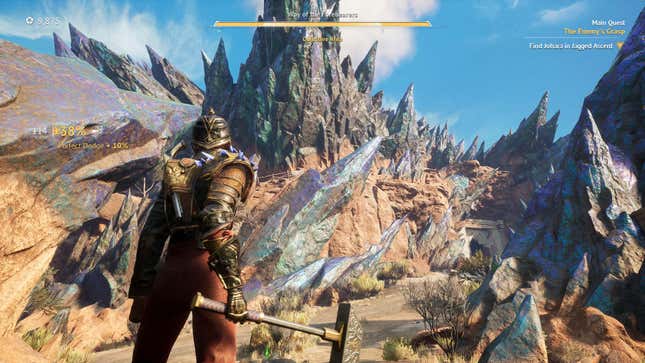
While Flintlock may very well serve the purpose of introducing or re-introducing you to a sometimes-abrasive genre, it’s also unique and fun in its own way. But oh, dear reader, I didn’t feel that way at first. I’m very happy to say that Flintlock grew on me, but it had to claw its way out of some bad first impressions.
A rough start to a rough world
In my first hour or two of Flintlock, I didn’t think we were going to get along. I’d bemoan playing this game to coworkers, friends, and even once on a date. And while I did come to appreciate elements of the narrative by the end, I’m not convinced Flintlock introduces its story, world, and characters very well.
Flintlock rushes through essential opening moments in a way that prevented me from fully soaking in all the important, foundational story beats. As a result, I spent much of the game not really understanding exactly what was going on. Sure, it was clear that there were undead. There were bad gods. Humanity was in a shitty state. Enki was maybe a trustworthy friend? At the very least, he was beyond adorable.

The game was eager to talk about what was going on as if I should know, but it was rough. I reached a point where I just accepted what I was supposed to do: Gods bad. Swing ax and shoot. But it felt like I was just being swept along in a story whose basics had gone over my head . An in-game glossary or codex of some kind that could define basic terms or give me a running summary of events would’ve dramatically improved this.
Part of my misunderstanding, I suspect, was due to Flintlock’s very unfortunate audio treatment. While A44 did stress that the pre-release build I had access to during my review (which was mostly issue-free aside from a strange, non-game-breaking UI bug) didn’t have adjustable “2D cinematic audio,” there were issues with the sound that I worry a day-one patch might not be able to fix.
It was remarkably difficult to hear what characters were saying at times. I repeatedly dove into the audio settings to try and address this, but more often than not, characters would sound muffled and distant. And even when the voices were direct, there was a strange timbre to the audio recordings that made it hard for me to understand them. I had to turn the subtitles on and leave them on for the whole game.

Flintlock also has frequent ambient character dialogue between Nor and Enki, almost to Forspoken levels of persistent chatter (seriously, Enki, stop commenting every time I pickup crafting materials or jump into rifts). It wasn’t too annoying, but it would erupt during combat! So, sorry Nor, I can’t focus on your important, character-building story about your upbringing because there’s a horde of undead losers ready to rip my flesh out.
Read More: Forspoken: The Kotaku Review
This wasn’t the only issue I had with the audio. The volume levels of sound effects and music were all over the place. I’d knock down the music a few times because it was too loud. Then, despite my lowering it, it would sometimes soar to incredibly high levels, leading me to either turn my speakers down or once again dive into the settings.
Sound effects across the board were equally uneven. Oftentimes, they would just erupt in remarkably loud and abrasive ways (and that’s coming from someone who enjoys loud, abrasive music and sounds).
It’s a shame because the fundamental quality of the sounds and the soundtrack are quite good (boss fight music in particular, though often too loud, is well-written and evocative). They’re just mixed and presented in a way that doesn’t showcase their foundational strengths. After playing this game on PC with studio-quality stereo monitors, headphones, and a Windows-based Steam Deck competitor, I couldn’t manage to get a decent audio experience and just had to live with it.
But as I put up with feeling like I had half an understanding of the narrative and an audio experience that would continue to fight me harder than any enemy in the game, Flintlock opened up to reveal a fun time that I’m sad wasn’t longer.
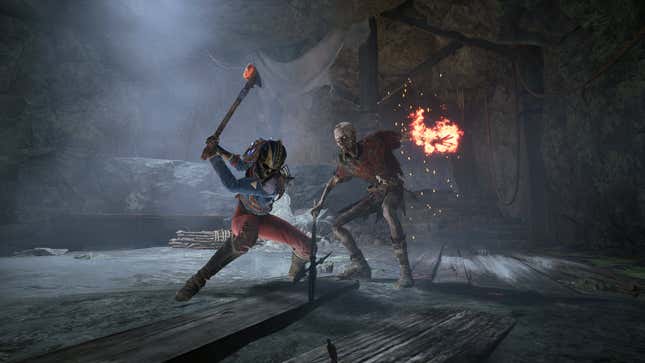
Potential realized, to sadly be cut short
As I said earlier, Flintlock is a fantastic way to experience the thrills and satisfaction of a soulslike without constantly getting sent to “You Died” screens. But it amounts to more than just an on-ramp to this kind of game. While I’m now looking at my calendar to figure out how to schedule in some quality personal time with other games of this kind, I’m sad I won’t be playing more Flintlock, at least not without a New Game Plus option, which the game currently lacks.
Nor gets a melee weapon—an ax or hammer—along with a black powder gun that recharges its ammo as you land successful hits. You also have access to more powerful rifles, grenade launchers, and other armaments that typically require you to manually reload each shot and can be aimed like a gun in a standard, over-the-shoulder third-person shooter. Firearms do decent damage on their own at times, but they’re also very useful for stopping an enemy from unleashing a more powerful, unblockable attack. And when you’re in the heat of a boss fight and manage to manually reload a black powder rifle just in time to bring it up to aim, fire, and stop them from hitting you with a devastating blow, it’s great fun every time.
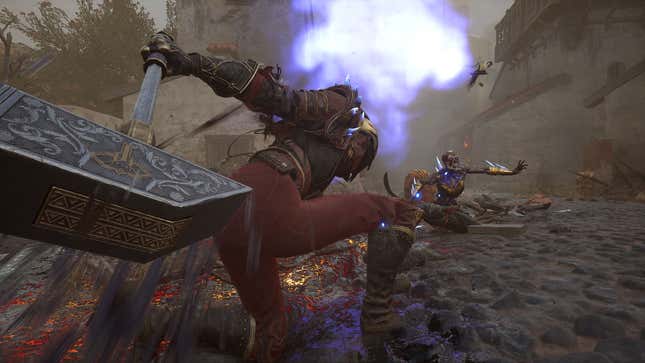
Nor’s companion, Enki, provides her with magical augmentation to her attacks. He also has his own attack button which builds up a stagger-esque meter that, once filled, allows you to either one-shot a weaker enemy, or eliminate the armor of more powerful enemies, making them way more vulnerable. Attacking enemies in that vulnerable state triggers cinematic moments that see the camera swoop in close as Nor satisfyingly pummels her opponents in ways that remind me of Hellblade II’s visceral depictions of melee combat. Combined with her occasional taunts at enemies, combat in Flintlock makes you feel powerful, and it wants you to.
Read More: Senua’s Saga: Hellblade II: The Kotaku Review
One particularly interesting element of Flintlock’s combat is how it handles XP, or “Reputation” as it calls it. As you defeat enemies and pull off successful combat maneuvers, you’ll earn Reputation that you can spend on upgrading your proficiency with firearms, magic, and melee weapons. You lose the Reputation you’re carrying around if you die twice without recovering it. That part’s pretty standard. But what’s unique is that during combat, you build up Reputation in a separate meter, where it’s increased by a percentage multiplier that goes up as you continue to land successful hits and dodge attacks. You can pull your Reputation out of that separate meter at any time to “cash it in,” as it were, by holding a button, or you can choose to let it build up and increase in value as you continue to play the game more proficiently. Get hit, and the multiplier gets reset, adding what Reputation you earned to your current total. The longer you’re able to sustain your Reputation multiplier by avoiding damage, the more you’ll earn.
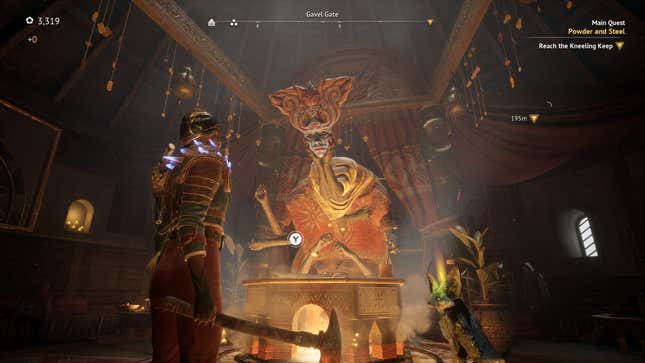
This mechanic encourages you to do better in combat in more ways than just punishing you with death should you fail. The HUD indicates the successful combat moves you pull off, and you come to learn the system pretty well while playing, picking up on ways to avoid hits and find better openings to land attacks. By the end of the game, its benefits were less about the experience multiplier, and more about helping me conceptualize the fighting in a way that I expect will cross over to other games in the genre. Flintlock’s mechanics are well composed and easy to understand, helping you sustain the highs of doing well in a hard action RPG rather than learning from suffering crushing lows too often.
That said, it is an easier game than many it takes clear inspiration from, both in its lower level of difficulty and its systems that encourage you to play smarter. In my single run of the campaign, I died less than a dozen times and only switched to easy mode because I encountered a boss whose second phase was so hectic, it was beyond anything the game had taught me to fight before. Still, though it was relatively easy, I still feel like I learned a combat system that had nuance and interesting challenges. And I was eager for more.
Unfortunately, as soon as I really got into the groove of this combat system, and was starting to finally catch up with a story that felt like it had left me behind, the game was nearing its conclusion.
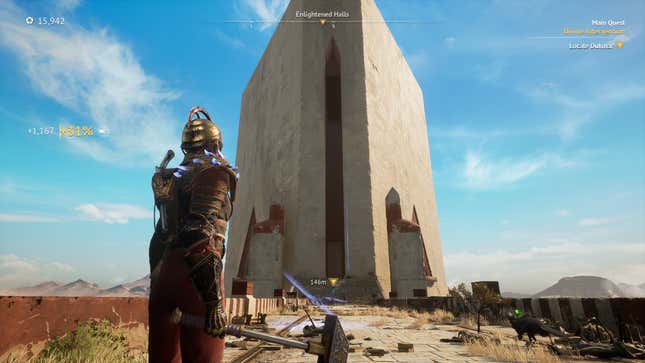
I ultimately completed it in about 10 hours with a full run of the story and a sizable chunk of the side quests. Some might delight at the prospect of such a short, manageable runtime, especially as many modern games seemingly want to occupy endless hours. But I’d argue that Flintlock deserves to last longer on the merits of its own satisfying, approachable, and fun gameplay loop.
The game features an introductory sequence, two semi-open-world environments filled with enemies, camps to liberate, coffee shops to visit, side-quests, and a conclusion. I so wish Flintlock would’ve had at least one more semi-open world environment to explore. The game sells for less than $40 brand new, but I don’t feel like I want more Flintlock for the sake of value. I want more Flintlock to play more Flintlock.
Flintlock deserves more, now and hopefully later
Flintlock won’t provide you with your next “get gud” level of challenge. It’s not an invitation to bark down at people who don’t have the time or experience to invest in harder games over “skill issues.” I was a bit let down by some of its presentational issues and murky storytelling, but in the end, I found myself just wanting more of this combat. Flintlock has encouraged me to jump further into a genre that used to turn me off. If you’ve struggled with the soulslike genre in the past, you might find this game to do the same.

But it’s not just the combat. The setting and world design is very inspired, with some gorgeous art and wonderful environmental designs. Nor and Enki’s discussions as they explore the world bring up topics of human traditions in response to the duality of life and death. There’s personality and heart at the core of Flintlock that I’d like more of, and that’s especially welcome considering how cryptic and austere games in this genre often are. I found the ending to be a little ambiguous, perhaps hinting that there’s more story to tell. And I really hope that’s the case. I want to see more of these characters, this world. They deserve more time on screen.
Flintlock: The Siege of Dawn has its issues, but I think A44 Games has hit upon something special here, creating both an approachable form of soulslike gameplay and a unique, non-conventional fantasy setting that isn’t just another pseudo-European medieval landscape dominated by white men. The game could’ve really reached something greater with an extra five or so hours of gameplay. But what’s on offer here is a low barrier to entry for a genre that is often too eager to delight in your misery.
Buy Flintlock: The Siege of Dawn: Amazon | Best Buy
.


